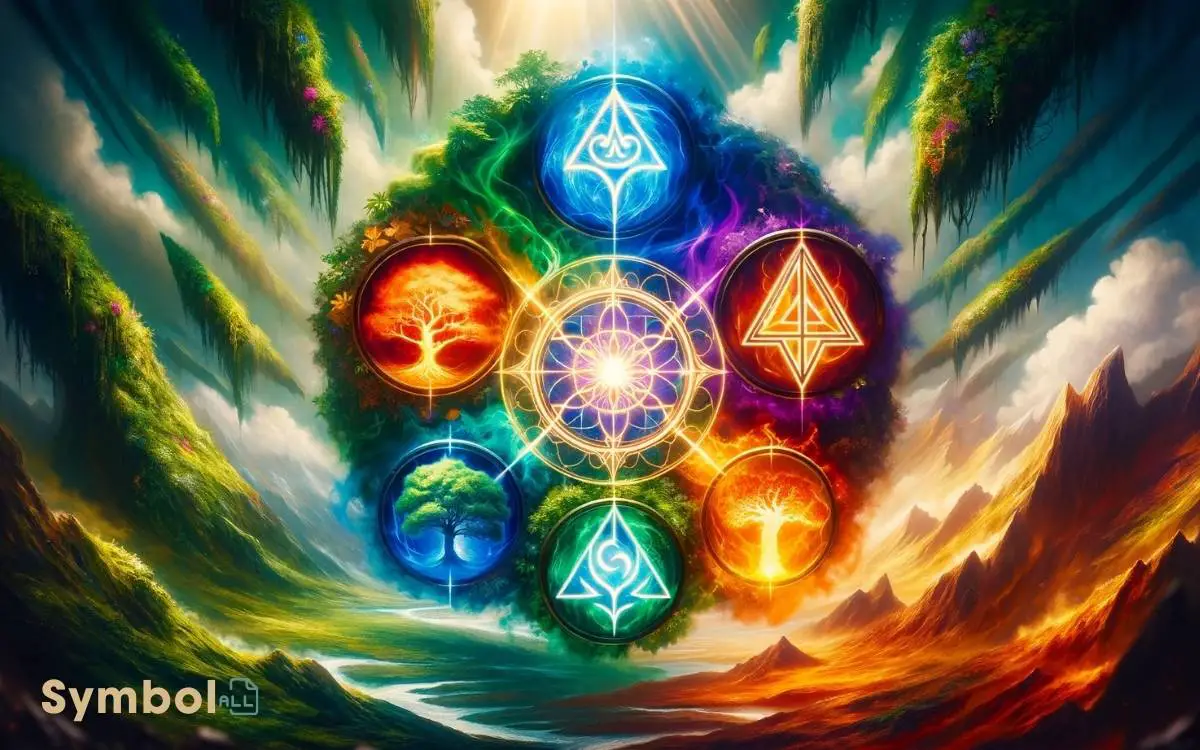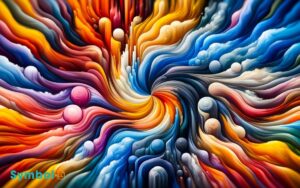Magic the Gathering Color Symbols: A Complete Guide!
In Magic the Gathering, each color symbol isn’t just a choice; it’s a strategy that reflects your play style and ideology.
White champions order, blue strategizes with knowledge, black embraces power through sacrifice, red burns with passion for freedom, and green grows with life‘s interconnection.
These symbols guide your deck-building, influencing mechanics and storytelling deeply. They’re your entrance into a world of rich lore and intricate gameplay interactions.
Understanding them is key to mastering the game, as every color introduces unique strategies and outcomes.
Dive deeper, and you’ll discover how blending these colors can reveal even more powerful pathways to victory.

Key Takeaway
The Essence of Color Symbols
At the core of Magic the Gathering’s intricate gameplay, the five color symbols represent the foundational philosophies and powers that shape the universe of the game.
You’re not just choosing colors; you’re aligning with deep-seated ideologies and strategies that dictate how you play.
Each color symbol holds a unique identity, influencing the mechanics, abilities, and even the storytelling of the cards it encompasses.
These symbols aren’t mere decoration; they’re a gateway to understanding the rich lore and complex interactions within the game.
As you explore the color wheel, you realize it’s a reflection of the game’s balance and diversity. Recognizing the essence of these symbols is vital for mastering the game, as it informs your deck-building strategies and gameplay decisions, ensuring a more engaging and rewarding experience.
White: Order and Light
In Magic the Gathering, the color white symbolizes the pillars of community and harmony, law and structure, alongside healing and protection.
You’ll find that its ethos is deeply rooted in the principles of collective well-being, ensuring each card reflects a commitment to peace and organization.
This color champions the idea that strength and resilience are born from unity and meticulous order, offering a unique approach to gameplay that emphasizes strategic defense and mutual support.
Community and Harmony
Delving into the world of Magic the Gathering, the color White symbolizes a profound sense of community and harmony, embodying principles of order and light that guide players toward unity and collective strength.
In gameplay, this manifests through mechanics that bolster group tactics, such as ‘banding‘ or ‘convoke‘, where the synergy between creatures and spells shines brighter than individual might.
White’s philosophy hinges on the belief that together, players can achieve more than the sum of their parts. It’s not just about assembling forces; it’s about creating a cohesive unit where every element supports the others.
This ideology extends beyond the battlefield, fostering a game environment where cooperation and mutual respect are just as important as victory.
Law and Structure
White’s embodiment of law and structure offers a strategic foundation that enforces order and light, guiding players through a domain where rules and organization reign supreme.
In the domain of Magic the Gathering, this facet is essential, as it translates to gameplay mechanics focusing on control and restriction.
You’ll find that white cards often implement strategies that limit opponents’ actions or enforce rules that benefit structured play.
This color’s philosophy leans heavily on the idea that with proper governance and adherence to a well-defined set of rules, victory isn’t just probable but assured.
Analyzing white’s role, it’s clear that it serves as the backbone for players who appreciate precision and predictability in their strategy.
It’s not just about restricting the chaotic; it’s about creating a landscape where every move is calculated and every strategy is meticulously planned.
Healing and Protection
Beyond its foundation of law and structure, white magic also excels in offering unparalleled healing and protection, serving as a bastion of safety for its adherents.
This aspect of white magic isn’t just about negating damage but encompasses a wide array of strategies that keep you and your creatures safe while outmaneuvering opponents.
- Life Gain: Spells and abilities that increase your life total, sometimes dramatically, ensuring you can withstand your opponent’s assaults.
- Damage Prevention: Cards that prevent or reduce damage, whether from combat or spells, keeping your forces intact.
- Restoration: Abilities that can bring creatures back from the brink of destruction or even from the graveyard itself.
- Protection: Spells that can make your creatures or even yourself immune to specific colors or types of spells, creating strategic advantages against opponents.
Understanding and leveraging these elements can turn the tide of battle in your favor, showcasing the depth of strategy within white magic.
Blue: Knowledge and Control
In the domain of Magic the Gathering, blue symbolizes the pursuit of knowledge and the authority of control, shaping the game’s strategic depth with its unique abilities.
You’ll find blue’s essence woven into spells that manipulate the flow of the game, allowing you to draw more cards, thereby gaining more options, or to counter your opponent’s moves directly.
This color thrives on anticipation and adaptation, enabling you to dictate the pace and direction of the match.
By mastering blue, you’re not just playing cards; you’re engaging in a mental duel, where foresight and flexibility lead to victory. It’s not merely about having the power but knowing how and when to wield it, making blue a formidable force in the hands of a strategic player.
Black: Power and Sacrifice
In the domain of Magic the Gathering, the black color symbolizes a path where you’ll embrace dark ambitions to gain power at any cost.
You’ll explore sacrificial strategies, trading resources, creatures, or even your own life points for greater control and devastating effects.
Ultimately, black teaches you that death itself can be a resource, offering rewards for those willing to pay its price.
Dark Ambitions
Black’s pursuit of power often demands the ultimate sacrifices, embodying a relentless drive that shapes its dark ambitions.
This ambition isn’t without its complexities, weaving a narrative of depth and intrigue into the fabric of Magic the Gathering.
- Individualism at its core: You’re not just building a deck; you’re crafting a narrative of ambition and power.
- Manipulation and control: Through strategic plays, you bend the game to your will, showcasing the cunning that black mana embodies.
- Resourcefulness: Every card, every piece of mana, becomes a tool in achieving your endgame.
- Moral ambiguity: The lines between right and wrong blur, offering a nuanced approach to victory.
Understanding these elements enriches your gameplay, providing a deeper appreciation for the strategic depth that black mana offers.
Sacrificial Strategies
Delving into the heart of black mana, you’ll uncover sacrificial strategies that channel power through loss, showcasing a vital aspect of its relentless pursuit for dominance. This approach relies on the concept that some gains require sacrifices.
You’re not just playing cards; you’re making calculated choices about what to give up in order to achieve a greater goal.
Black mana spells often demand the sacrifice of creatures to trigger potent abilities or to weaken your opponent’s forces.
It’s a delicate balance, where the cost of your actions must always be weighed against the potential benefit.
Understanding this dynamic is pivotal. You’ll learn to leverage your resources wisely, sacrificing what’s necessary to pave the way for victory.
This strategy embodies the essence of black mana’s power, where every loss is a step closer to ultimate control.
Deaths Rewards
Harnessing the dark essence of black mana, you’ll discover that death’s rewards offer a compelling blend of power and sacrifice, transforming loss into a strategic advantage on the battlefield.
In Magic the Gathering, black symbolizes the macabre dance with death, where every demise fuels your ambition.
- Recursion: Black spells often bring creatures back from the graveyard, letting you reuse them.
- Sacrifice mechanics: Sacrificing your creatures can trigger powerful effects, making each loss a calculated step toward victory.
- Life as a resource: You’ll leverage your life points to draw cards or destroy threats, embodying the adage that power requires sacrifice.
- Swarm strategies: Black excels in generating numerous disposable creatures, overwhelming opponents through sheer numbers.
This approach requires a keen understanding of when to hold back and when to embrace the void, turning the tide of battle in your favor.
Red: Freedom and Passion
In the world of Magic the Gathering, red symbolizes the fiery spirit of freedom and the unbridled force of passion that drives its wielders.
This color champions the cause of individuality and spontaneity, often manifesting in cards that prioritize speed, disruption, and direct damage.
As a player aligning with red, you’re tapping into the raw energy that fuels both creation and chaos. It’s a color that doesn’t shy away from risk; instead, it embraces it, turning the battlefield into a place where the unexpected can and does happen.
Red’s philosophy is straightforward: act now, think later. This ethos is mirrored in its cards, which encourage aggressive strategies and capitalize on the moment’s heat. Red is about living fervently and fighting for what you believe in, without hesitation or regret.
Green: Growth and Interconnection
Green’s essence lies in its profound connection to growth and the intricate web of life that it nurtures across the multiverse of Magic the Gathering.
You’ll find that this color symbolizes not just essential growth, but also the development of life in all its forms, emphasizing the natural cycle and balance that sustains the ecosystem.
- Creatures and Nature: Green’s cards often feature the mightiest creatures and vast, untamed wilds.
- Mana Acceleration: It excels in generating resources, quickly bringing powerful beings into play.
- Life Gain: Green is adept at restoring life points, symbolizing vitality and resilience.
- Enchantment and Artifact Destruction: It embodies the primal force that breaks the shackles of artificial constructs, returning them to the earth.
Color Combinations and Strategies
Why adhere to one color when merging Magic the Gathering’s color palettes can unveil powerful and diverse strategies? Delving into dual or multiple color decks reveals synergies not achievable within single colors.
For example, combining blue’s control and manipulation with red’s direct damage enables a dynamic playstyle, dominating the board while gradually reducing the opponent’s life.
Likewise, green’s creature growth potential merged with white’s ability to shield and enhance creates an almost unbeatable force of nature on the battlefield.
Each color combination presents a unique strategic pathway, prompting you to analyze your deck’s strengths and weaknesses critically.
Mastering these pairings requires a profound understanding of each color’s essence and how they can complement or counteract one another, resulting in more intricate and efficient gameplay.
Symbolism in Deck Building
Exploring symbolism in deck construction shows how every card’s imagery and color can greatly influence your strategy and gameplay.
The symbolic meaning behind colors and images isn’t just for show; it’s a strategic layer that adds depth to your deck building process.
- Color Identity: Each color symbolizes different philosophies and playstyles. Aligning your deck’s theme with its color’s symbolism can enhance your strategic approach.
- Imagery: The artwork and symbols on cards can guide the thematic direction of your deck, providing not just aesthetic pleasure but also strategic cues.
- Archetypes: Certain symbols recur across archetypes, helping you choose cards that synergize well.
- Cultural References: Understanding the lore and cultural references behind symbols can uncover hidden synergies or strategies.
Analyzing these elements allows you to craft a deck that’s not only competitive but also deeply personal and thematically cohesive.
The Impact on Gameplay
The colors you choose for your Magic the Gathering deck greatly influence how you play the game, dictating both your strategies and potential outcomes.
Each color embodies unique philosophies, mechanics, and play styles, shaping the way you interact with opponents and the game itself.
For instance, a deck emphasizing Blue often focuses on control and manipulation, allowing you to dictate the pace and flow of the match.
On the other hand, Red’s aggressive and direct damage approach pushes you to overwhelm opponents quickly.
Combining colors opens up a vast array of strategic possibilities, challenging you to find synergies and balance between their inherent strengths and weaknesses. Your color choice isn’t just a preference; it’s a declaration of your planned path to victory.
Conclusion
In your journey through the multiverse of Magic: The Gathering, you’ve seen how the essence of color symbols shapes destinies. These color symbols are more than just mana sources; they embody philosophies, emotions, and conflicts that define every duel and story. Their influence mirrors ancient traditions, leading some to draw parallels between them and esoteric systems, with masonic color symbolism explained as a tool for understanding deeper meanings within hues. Just as the balance of white, blue, black, red, and green drives a player’s strategy, so too does the deliberate use of color reveal hidden layers of power and intention in both Magic and mystic lore.
Like the legendary Planeswalkers, you wield these symbols to forge your path, blending order with chaos, knowledge with power.
Your deck, a tapestry of strategies and dreams, reflects not just a game, but a reflection of yourself. Remember, in the clash of colors, your choices illuminate the battlefield, turning mere cards into epic tales of victory and discovery.






